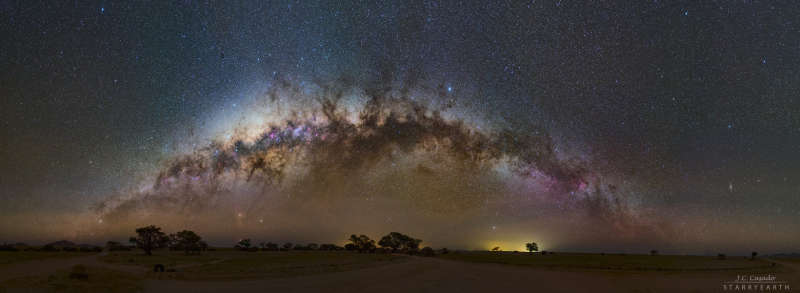
|
Explanation: Under dark skies the setting of the Milky Way can be a dramatic sight. Stretching nearly parallel to the horizon, this rich, edge-on vista of our galaxy above the dusty Namibian desert stretches from bright, southern Centaurus (left) to Cepheus in the north (right). From early August, the digitally stitched, panoramic night skyscape captures the Milky Way's congeries of stars and rivers of cosmic dust, along with colors of nebulae not readily seen with the eye. Mars, Saturn, and Antares, visible even in more luminous night skies, form the the bright celestial triangle just touching the trees below the galaxy's central bulge. Of course, our own galaxy is not the only galaxy in the scene. Two other major members of our local group, the Andromeda Galaxy and the Triangulum Galaxy, lie near the right edge of the frame, beyond the arc of the setting Milky Way.
|
January February March April May June July August September October November December |
| ||||||||||||||||||||||||||||||||||||||||||||||||
NASA Web Site Statements, Warnings, and Disclaimers
NASA Official: Jay Norris. Specific rights apply.
A service of: LHEA at NASA / GSFC
& Michigan Tech. U.
Based on Astronomy Picture
Of the Day
Publications with keywords: Milky Way
Publications with words: Milky Way
See also:
- APOD: 2025 July 2 Á Milky Way Through Otago Spires
- APOD: 2025 May 20 Á Milky Way over Maunakea
- APOD: 2025 May 13 Á Gaia Reconstructs a Top View of our Galaxy
- APOD: 2025 May 12 Á Gaia Reconstructs a Side View of our Galaxy
- Galaxies in Space
- APOD: 2025 February 9 Á Milky Way over the Australian Pinnacles
- APOD: 2024 November 24 Á Journey to the Center of the Galaxy
